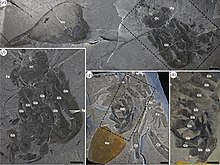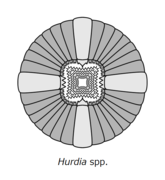Hurdia
| Hurdia | |
|---|---|

| |
| Reconstruction of H. victoria (top) and H. triangulata | |

| |
| Disarticulated fossils | |
| Scientific classification | |
| Domain: | Eukaryota |
| Kingdom: | Animalia |
| Phylum: | Arthropoda |
| Class: | †Dinocaridida |
| Order: | †Radiodonta |
| Family: | †Hurdiidae |
| Genus: | †Hurdia Walcott, 1912 |
| Type species | |
| †Hurdia victoria Walcott, 1912
| |
| Other species | |
| |
Hurdia is an
Description
Hurdia was one of the largest organisms in the Cambrian oceans, H. victoria reached approximately 30 cm (12 in) in length, while H. triangulata reached up to just 8 cm (3.1 in).
Ecology
Hurdia is either suggested to have used its frontal appendages to sift small prey from sediment, or to have used them as a trap to capture larger benthic (seafloor dwelling) prey.[5]
Distribution
Hurdia had cosmopolitan distribution; it has been recovered from the
Taxonomic history
Hurdia was named in 1912 by Charles Walcott, with two species, the type species H. victoria and a referred species, H. triangulata.[6] The genus name refers to Mount Hurd.[6] It is possible that Walcott had described a specimen the year prior as Amiella, but the specimen is too fragmentary to identify with certainty, so Amiella is a nomen dubium.[7] Walcott's original specimens consisted only of H-elements of the frontal carapace, which he interpreted as being the carapace of an unidentified type of crustacean. P-elements of the carapace were described as a separate genus, Proboscicaris, in 1962.
In 1996, then-curator of the Royal Ontario Museum Desmond H. Collins erected the taxon Radiodonta to encompass Anomalocaris and its close relatives, and included both Hurdia and Proboscicaris in the group.[8] He subsequently recognized that Proboscicaris and Hurdia were based on different parts of the same animal, and recognized that a specimen previously assigned to Peytoia was also a specimen of the species.[7] He presented his ideas in informal articles,[9][10] and it was not until 2009, after three years of painstaking research, that the complete organism was reconstructed.[3][11][12][13]
Sixty-nine specimens of Hurdia are known from the Greater Phyllopod bed, where they comprise 0.13% of the community.[14]
See also
References
- PMID 30218075.
- ^ S2CID 86465719.
- ^ S2CID 206517995.
- S2CID 205242881.
- PMID 34284622.
- ^ a b Walcott, Charles D. (1912-03-13). "Middle Cambrian Branchiopoda, Malacostraca, Trilobita, and Merostomata". Smithsonian Miscellaneous Collections. 57 (6).
- ^ S2CID 86465719.
- S2CID 131622496.
- ^ D. Collins, in North American Paleontological Convention, Chicago, Abstracts with Programs, S. Lidgard, P. R. Crane, Eds. (The Paleontological Society, Special Publication 6, Chicago, IL, 1992), p. 66, 11.
- ^ D. Collins (1999). "Dinocarids: the first monster predators on earth". Rotunda. Vol. 32. Royal Ontario Museum. p. 25.
- ^ Fossil fragments reveal 500-million-year-old monster predator.
- ^ New animal discovered by Canadian researcher.
- ^ Scientists identify T-Rex of the sea
- S2CID 53646959.
External links
- "Hurdia victoria". Burgess Shale Fossil Gallery. Virtual Museum of Canada. 2011. Archived from the original on 2020-11-12.





